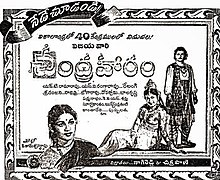|
Chandraharam
Chandraharam is a 1954 Indian swashbuckler film directed by Kamalakara Kameswara Rao in his debut. It was produced by Nagi Reddy-Chakrapani under the Vijaya Productions banner. The film, a Telugu-Tamil bilingual, stars N. T. Rama Rao, Savitri and Sriranjani Jr., with music composed by Ghantasala.[1] It was not commercially successful.[2][3] PlotThe film begins in the kingdom of Chandana Desam. a baby boy, Chandanraju, is born to its king by the boon of Chandra with a necklace Chandraharam which preserves his life. At the age of five, Maali Chandan's mentor starts turning him into a jack of all trades with ethical & royal moralities. Years roll by, and Chandan must get nuptial lest his life is in danger; hence, his parents procure portraits of neighboring princesses. All the while, Chandan has a dream girl and affirms to knit her. The king edicts Maali to quest for the girl and sends Chandan to tour the country. Chandan's sly brother-in-law, Dhoomekatu, wants to usurp the kingdom and ploys to break Chandan's intention and sends his sidekick, Niksheparayudu, behind him. Niksheparayudu detects the girl Gauri and tricky hides her. Besides, Chanchala is an angel who entices Chandan, which he denies. So, she snatches his Chadraharam and says he will be alive only in the night. Meanwhile, Gauri absconds and collapses when Chanchala's sister Achala aids her land at Chandan, whom Maali splices. Dhoomketu threatens the king to crown him, and as inevitable, he agrees. During this time, Niksheparayudu detects Gauri's presence at Maali's residence, whom he put out of sight in a temple. Consequently, infuriated Chanchala kills Chandan when Dhoomketu incriminates and sentences Gauri to the funeral pyre. At last, Gauri's adoration retrieves Chandan to life. Chanchala is cursed by Indra by stripping her divinity. Dhoomekatu & Niksheparayudu also plead pardon. Finally, the movie ends on a happy note with the crowning ceremony of Chadanraju. Cast
MusicTelugu songsMusic was composed by Ghantasala. Lyrics were written by Pingali Nagendra Rao.[4]
Tamil songsLyrics by Thanjai N. Ramaiah Dass.[5]
ProductionThe film was produced by Nagi Reddy and Chakrapani under the banner Vijaya Pictures simultaneously in Telugu and Tamil. This is the directorial debut for Kamalakara Kameswara Rao. The cinematography was by Marcus Bartley. Chakrapani wrote the story while Pingali Nagendra Rao wrote the dialogues and lyrics for the Telugu version.[1] Thanjai N. Ramaiah Dass wrote the dialogues and lyrics for the Tamil version.[5] References
External links
|
||||||||||||||||||||||||||||||||||||||||||||||||||||||||||||||||||||||||||||||||||||||||||||||||||||||||||||||
Portal di Ensiklopedia Dunia
